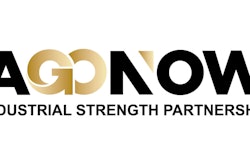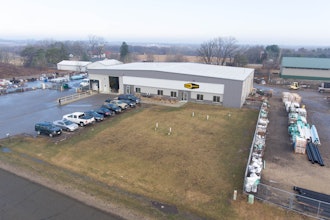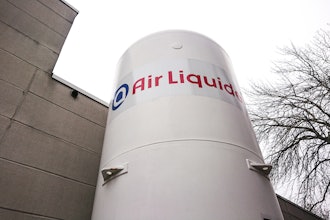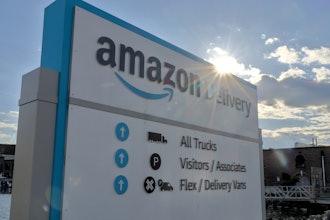© 2017 SAP SE or an SAP affi liate company. All rights reserved.
The Path to the
Connected Distributor
Whitepaper
2
© 2017 SAP SE or an SAP affiliate company. All rights reserved.
Whitepaper – The Path to the Connected Distributor
TABLE OF CONTENTS
A Transformation Imperative 2
Key Trends Affecting Wholesale Distribution 2
Wholesale Distribution Up Until Now 4
What Customers Are Saying 5
The Connected Distributor 6
Driving Customer Centricity through Contextual Engagement 6
Re-Tooling the Sales Kit 6
Targeting New Revenue Streams 7
Data Is King 7
Proactivity Helps Guide Customer Decisions 8
Digitizing Is Not the Same as Transforming 8
Agility Is the Hallmark of Modern Business 8
Key Business Goals for Wholesale Distribution 9
The Net-Net of Transformation 10
3
© 2017 SAP SE or an SAP affiliate company. All rights reserved.
Whitepaper – The Path to the Connected Distributor
A Transformation
Imperative
Today’s economy is far more sophisticated and
agile than in previous decades. In the B2B and
B2C worlds, the primary point of focus is the
individual customer. The chief catalyst is data,
and the medium that brings it all together is the
Internet.
Wholesale distributors must seriously review and
redefine their business models to capitalize on this
change. At stake are all current revenue streams, and
many new ones, some of which may be entirely novel
and external to any existing five-year plan.
B2B buyers are more sophisticated than ever and
expect the same customer experience in business
that they have come to rely on in their personal lives
as consumers empowered by digital technologies.
The Omni-channel experience includes high-touch
and personal experiences across online, telephone,
and in-person interactions.
Of greatest importance in wholesale B2B selling
are the ideas of customer centricity and the use of
data and agility throughout the distribution stream.
Embracing new best practices here allows for more
opportunities in all other areas of business support,
including marketing, commerce, sales, and service.
In short, the wholesale distributor must transform
into a connected distributor.
© 2017 SAP SE or an SAP affi liate company. All rights reserved.
Whitepaper – The Path to the Connected Distributor
Key Trends
Aff ecting
Wholesale
Distribution
Traditionally, wholesale distributors have worked
outside of the spotlight – purchasing, coordinating,
and moving products in bulk, allowing the public
eye to come to rest exclusively on the retailers who
operate at the end of the line. However, disruptive
forces are pushing all the way up the channel, and
aff ecting distributors directly.
Evidence of this is apparent in the results of a
September 2015 study1 conducted by Forrester
Consulting, commissioned by SAP Hybris and
Accenture.
The top three investment drivers for Omni-channel
sellers were customer-specifi c.
THOSE THREE DRIVERS ARE:
• Meeting customer expectations
• Providing a consistent experience across channels
• Recognizing the higher lifetime value of the
Omni-channel customer
This is especially signifi cant since these
considerations edged out cost savings,
competitiveness, and growth issues as priorities.
This accentuates the fact that commerce is changing
across the board, and directly aff ecting distributors.
1 Mastering Omni-Channel B2B Customer Engagement, September 2015, Forrester Consulting,
commissioned by SAP Hybris and Accenture.
5
© 2017 SAP SE or an SAP affiliate company. All rights reserved.
Whitepaper – The Path to the Connected Distributor
Base: 450 (2015) and 526 (2014) business decision-makers with more than 1,000 employees (500+ in Europe) in North America and Europe
Source: A commissioned study conducted by Forrester Consulting on behlaf of SAP Hybris and Accenture Cigital, September 2015
What would you say are the primary drivers behind your organization's
investment in omni-channel initiatives?
100%
74%
65% 64% 60%
55%
51%
54%
50%
53%
49%
59% 56%
41%
36%38%33%
66%70%
40%
90%
60%
30%
80%
50%
20%
10%
Meet customer expectations
Omni-channel customer has
a higher lifetime value
Match our competitors'
practices
Provide a consistent
experience across channels
Drive additional efficiencies
and cost savings
See an uplift in our custom-
er satisfaction metrics
Gain a competitive edge
over online pure-plays
Reduce customer service /
call center expenses
International growth /
globalization
2015 2014
6
© 2017 SAP SE or an SAP affiliate company. All rights reserved.
Whitepaper – The Path to the Connected Distributor
Below are five significant ways
this is happening:
COMMERCE HAS BECOME HIGH TOUCH AND PERSONAL. Consumers are experiencing
greater personalization and power while shopping for themselves, online and in-store.
They receive instant information on price and availability and enjoy tailored service. They
carry this expectation across to their interactions in B2B, and this includes the supply side.
Wholesalers are facing pressure to alter their operations rapidly and radically, and provide
the same type of end-to-end tailored service that has become routine in retail.
COMPETITION IS INCREASINGLY ORIGINATING FROM NON-TRADITIONAL SOURCES,
including online giants like Amazon, and manufacturers who sell direct. Disruptors are
moving into the markets and channels traditionally served by distributors. Wholesalers
are being squeezed, as brands weigh their options of selling direct or choosing other
marketplaces, none of which require the services of wholesale distributors.
GENERATIONAL ISSUES ARE ALSO HAVING AN IMPACT. The people who do the
purchasing are getting comparatively younger, many being part of Generation Y, and they
march to a different beat. Some people in sales and distribution face challenges with
understanding and catering to the needs and styles of millennial and Gen-Y buyers.
THE MARKETPLACE IS GAINING VELOCITY. Viral trends emerge instantly and
disappear just as quickly. Retailers constantly reinvent themselves and their offerings
for a demanding public. This compels every player in the industry to evolve more swiftly,
become more efficient, and provide more memorable customer experiences.
INDUSTRIES ARE CONSOLIDATING, reducing the need for wholesale distribution
services, and increasing market pressure. Agility and high touch are not terms that the
wholesale world has traditionally been familiar with, but the need to transform is pressing
and permanent.
Each of these trends has a significant impact on a business that has not had to face the minute-by-minute
influences that their retail partners have experienced – until now. These trends point to customers, not to
pricing or logistics, and this is a whole new ball game for distributors.
7
© 2017 SAP SE or an SAP affiliate company. All rights reserved.
Whitepaper – The Path to the Connected Distributor
RELATIONSHIPS:
Wholesale distribution has, for a
long time, relied on relationship
selling to capture and secure
customer loyalty and ensure
repeat business. Nurturing a
consistent customer base has
remained the primary method
for ensuring slow and steady
revenue growth over time.
TECHNOLOGICAL INERTIA:
Wholesalers and distributors
have been conservative in their
adoption of new technology. After
making significant investments
in ERP and other platforms, a
move into new forms of digital
commerce is difficult for some. To
many, the Omni-channel, mobile
world may seem like just another
disruptive IT expense. The
traditional approach has been
one of “slow and steady wins the
race,” paired with a belief that
industrial enterprises, craftsmen,
restaurants, canteens, resellers,
and consumers will always need
an intermediary to get the goods
to where they need to be. But,
this no longer applies universally.
APATHY TOWARD ONLINE
COMMERCE:
In past years, online commerce
has not played an important
role for wholesale distributors,
with respondents to an SAP
Hybris State of E-Commerce in
Distribution2 survey reporting
that only 5% to 10% of their
total sales are coming from that
space. This is significant in light
of reports on buyers’ changing
habits, which reveal that “70% of
B2B buyers are doing research
online before purchasing.”
2 The 2015 State of E-Commerce in Distribution survey was sponsored by SAP Hybris in partnership with
Modern Distribution Management and Real Results Marketing.
Wholesale Distribution
Up Until Now
Three fundamental concepts illustrate the traditional and
current status of the wholesale distribution industry.
8
© 2017 SAP SE or an SAP affiliate company. All rights reserved.
Whitepaper – The Path to the Connected Distributor
What Customers
Are Saying
At all levels, including B2B, customers have evolved to a level of sophistication in which the industry term
e-commerce is quickly becoming obsolete. To survive and thrive, every business must be digital to a significant
degree, and as such, the first “e” in e-commerce need not even exist. Online commerce is not optional. It
enhances customer relationships and retention. It opens up new markets and segments. It moves high-cost
customers into lower-cost channels.
Source: Mastering Omni-Channel B2B Customer Engagement, September 2015, Forrester Consulting, commissioned by SAP Hybris and Accenture.
of distributors will be
selling products online
by 2017.
of B2B buyers will complete
at least half of their
purchases online by 2017.
Source: SAP Source: US B2B eCommerce Forrester: 2015 To
2020, April 2015, Forrester Research
92% 56%
MOST CUSTOMERS ARE ALREADY THERE.
CONSIDER THE FOLLOWING STATISTICS:
38% of customers are using online channels
exclusively
Another 32% use a combination of online and
offline channels
B2B buyers are incorporating digital channels
more and more into their buyer journey
98% of global business buyers do at least some
online research on work-related purchases that
they make offline
Buyers are increasingly turning to consumer sites
to research products
While almost all respondents have access to a
company-mandated internal portal or a company-
dedicated buying website, they are using an array
of other sources to start researching products
and services that they purchase for work
9
© 2017 SAP SE or an SAP affiliate company. All rights reserved.
Whitepaper – The Path to the Connected Distributor
The Connected
Distributor
DRIVING CUSTOMER CENTRICITY THROUGH
CONTEXTUAL ENGAGEMENT
The supply chain that distributors support is
somewhat dated. A singular, linear sequence no
longer exists. A more accurate representation
is that of an ecosystem – an organic economy
where anyone who adds value can participate and
engage customers. This gives rise to the need for
individualized strategies, agility, and some surprising
symbiotic relationships.
It is imperative for distribution organizations to
embrace these developments and foster a renewed
customer-centric mind-set across every line of
business, a concept called contextual engagement.
Whether a supplier has one hundred, one thousand,
or ten million customers, each should be catered
to singularly and specifically. The tools exist to
help accomplish this, something that would have
been unimaginable and logistically impossible
just a few years ago. Big data, instantaneous
online communication, and mobile technologies
make it possible to get personally involved with
each customer, delivering relevant content and
personalized offers to win and retain business.
A number of properties must be developed within
an organization to foster a successful culture of
contextual engagement.
THESE INCLUDE:
• Agility, the capacity to pro-act and react in sync
with quickly changing customer demands
• Reduction of complexity in processes, allowing for
seamless, personalized contact
• Constant measurement and re-measurement
of data and facts about a customer’s needs and
history
• Unification of processes and resources to facilitate
direct, contextual service
• Self-service tools that allow the customer to drive
the relationship
• Development of tools that create a dynamic,
content-rich engagement environment
These tools help build a closer, more relevant
relationship with customers as they approach
the company online. This is just as applicable
to wholesale distributors’ relationships with
manufacturers and their customers as it is to the
general public, since they relate to stores.
3:1 B2B buyers prefer 3:1 to self-educate rather than speak to a sales representative.Source: SAP
89%
of business leaders believe that customer
experience will be their primary basis for
competition by 2016.
Source: Gartner
10
© 2017 SAP SE or an SAP affiliate company. All rights reserved.
Whitepaper – The Path to the Connected Distributor
RE-TOOLING THE SALES KIT
The role of the sales force is changing, and must be
updated in the wholesale environment. Since buyers
already have access to the information they need to
make purchase decisions, sales reps must adopt a
more proactive role as a trusted advisor, equipped
with collaborative selling capabilities and real-time
customer information, which together enables
them to service customers anytime, anywhere.
This requires investing in technologies that support
the customer journey, along with appropriate
interpersonal skills.
B2B customers are using their mobile devices to
research and buy online:
68%
37%
of contractors
use smartphones.
of contractors use tablets.
Source: Gartner
TARGETING NEW REVENUE STREAMS
A constantly updating marketplace becomes a prime
opportunity for distributors to uncover new revenue
streams. They are being discovered or invented
everywhere. A water utility is now likely to venture
into leak detection services. Sharing economy
companies like Uber and AirBnB have changed the
transit and hospitality businesses.
Established distributors can do the same, venturing
into new opportunities for delivery, fulfillment,
logistics, channel management, inventory
management, and more. The new economy demands
far less infrastructure and capital investment than
in previous decades, and this enhances the need for
agile, creative thinking.
The constant search for new revenue streams
is critical to the future of successful, profitable
wholesale distribution companies.
“Good metrics are incredibly difficult
to obtain. You can obtain all sorts
of information, but how much of
it relates to how much customers
stick with you when they have an
alternative choice, or come to you in
the first place?”
Finance director at a global manufacturing firm
DATA IS KING
Public-facing retailers have already learned
an essential lesson: a customer’s data is more
important than their dollars. Although the sale of an
item may yield a profit for a retailer, the information
a customer provides – such as interests, browsing
history, location, and demographics – becomes the
raw material used to generate high-touch, targeted
sales opportunities. This is the essence of consistent,
Omni-channel commerce – and it is valid for B2B
commerce, too.
• If a customer’s purchase information has been
stored once, it should never have to be re-entered.
• When a customer speaks to a service agent or sits
down with an account rep to commit to a sale, the
relevant information, such as contract, inventory
availability, delivery information, and customer
profile, should be easily accessible on the nearest
computer or smart device without backtracking or
delay, even in an area without Internet connection.
• When a customer reviews a vendor’s value
statement, it should be clear that it includes
service and solution models that help drive down
and manage total cost of ownership.
11
© 2017 SAP SE or an SAP affiliate company. All rights reserved.
Whitepaper – The Path to the Connected Distributor
Innovative wholesale companies must capitalize on
data-driven insights and make intelligent business
decisions to maximize marketing ROI. This is done
by leveraging big data to create a customer “golden
record” and analyzing both transactional and
behavior data in real time.
Innovators seek new ways to leverage the data
contained within ERP and CRM systems. They
recognize these platforms as the keys to future
commerce that will deliver more robust and
relevant information to the field more quickly. This
information will be packaged in ways that compete
not solely on price, but that also provide key account
reps with rich, accurate, real-time insights into
product capabilities and availability.
Agile use of data helps guard against competitors
who are already playing a new form of the game,
invading traditional markets. While many wholesalers
have positioned ERP as the central nervous system
of their operations, integrated commerce platforms
PROACTIVITY HELPS GUIDE CUSTOMER
DECISIONS
When data is available, a new opportunity arises
in the area of proactivity. Wholesalers can take the
lead in assisting their customers to make economic
choices, by leveraging the analytics of big data.
This may include early alerts to reorder,
opportunities for discounts, suggestions or nudges
to order other products that are related to current
purchases, but not in an obvious way, or simply
opportunities to save money, time, and resources.
Analytics allows the vendor to take the first step and
lead the customer to an even more suitable place.
expose ERP to customers in new and productive
ways, acting as a translator between customer
expectations and the order fulfillment process. Real-
time data benefits the end customer, who can gain
real-time insight into inventory, order status, and
other valuable information.
12
© 2017 SAP SE or an SAP affiliate company. All rights reserved.
Whitepaper – The Path to the Connected Distributor
Transformation means the connection between
wholesalers and their customers is all-encompassing
in its customer-centricity. A customer should control
the desired service level, from full service to self-
service, and this should be changeable during any
interaction.
Digitizing is not the
same as Transforming
Many companies have established mobile-friendly websites and a
social media presence, but this type of digitization does not equal
transformation. It is certainly better than nothing, and it does
allow customers to find solutions online, but does not represent
maximized transformation.
No matter the level a customer chooses, or the
channel they select – phone, desktop, smartphone,
or tablet – their choices and needs must instantly
and seamlessly connect with a supplier’s business
process automation.
13
© 2017 SAP SE or an SAP affiliate company. All rights reserved.
Whitepaper – The Path to the Connected Distributor
An agile mind-set allows for procedures that were
unheard of just a few years ago. For example,
marketing departments can generate real-time
product catalog updates so that physical documents,
in either print or PDF format, match their online and
mobile counterparts. Marketing content can flow
automatically into predefined design templates,
reducing labor hours and costs, while increasing
accuracy. Accurate and consistent product
categorization enables big data analyses of how
customers interact with the organization.
These types of innovations help distribution
management respond faster to changing conditions,
better aligning purchasing, sales, and supply chain
management, to maximize profitability and minimize
expenses. They require less time, staff, and resources
to perform data synchronization, which in turn
Agility is the Hallmark of
Modern Business
drives consistency across offline, online, and mobile
operations – as well as automated customization for
localized markets, regions, and business regulations.
According to a recent report by Forrester Research3,
US B2B ecommerce is on pace to reach $1.13
trillion by the year 2020. Forrester also predicts
that4 “combined spend on commerce and order
management platform technology in the U.S. will
grow at an annual compound growth rate of 10%
over the next four years, from $1.4 billion in 2014
to $2.1 billion by 2019. Leading this advance will be
manufacturing and wholesale trade firms.” They
further estimate that by decade end, “investment
in commerce technology by manufacturing and
wholesale firms in support of B2B selling channels
will exceed that of B2C retailers.”
3 US B2B eCommerce Forecast: 2015 to 2020, Forrester Research, Inc., April 2015.
4 The Forrester Wave™: B2B Commerce Suites Q2 2015, June 2015
14
© 2017 SAP SE or an SAP affiliate company. All rights reserved.
Whitepaper – The Path to the Connected Distributor
• Know your customers: use data to develop a
360-degree perspective.
• Engage through Omni-channel: demonstrate
integrity in each relationship with every person
across all touch points.
• Innovate your business model: commit to
reimagine your services and clearly understand
their value proposition in today’s digital
marketplace.
• Consider aftermarket strategies: opportunities
have opened up significantly to global competitors
and others within the supply chain.
• Tap into the Internet of Things: when machinery
can be remotely monitored and communicate
machine-to-machine, distributor and customer can
realize huge benefits.
• Rewire the business model for improved billing:
provide up-to-date revenue tools for real-time
collection.
• Focus on predictable recurring revenue to move
from a one-time transaction to a recurring
approach, building momentum and loyalty along
the way.
• Leverage B2B opportunities: bundle single product
sales with projects, service offerings, subscriptions,
and usage-based charging – configure pricing
terms and volume discounts, including shared/
pooled entitlements across thousands of recipients
in real time.
• Personalize and automate the buying process
through self-service portals.
Key Business Goals
for Wholesale Distribution
• Collect customer data to provide insights into what
was purchased, with customer-specific details
about when and how the purchase was made.
• Leverage this data as the base for predictive
analytics to drive future engagements, meeting
needs, and providing solutions – before the
customer even becomes aware of them.
• Implement customer service convenience
by handling queries through any touch point,
including email, phone, Web self-service portal,
chat, text, branded communities, and social media.
• Enable field service experts: give them the tools
to perform diagnostics, research inventory
information, and order spare parts on the spot.
• Ensure routing and escalation rules that are
seamless, instant, and complete, eliminating the
need for revalidation during all customer service
interactions.
• Use analytics for continuous improvement.
• Update loyalty marketing techniques: ensure
that incentives, rewards, and rebates for B2B
customers remain relevant.
• Control key marketing activities and tracking KPIs
from a single dashboard to understand the details
behind the numbers.
• Identify immediate and long-term opportunities,
including target marketing and aftermarket
strategies.
• Use mobile data to help key account managers
access names, customer data, industry news, and
customer pain points, even in offline mode, while
no Internet connectivity is available.
15
© 2017 SAP SE or an SAP affiliate company. All rights reserved.
Whitepaper – The Path to the Connected Distributor
Moving through a complete customer-centric
metamorphosis takes planning and should be done
in sequential steps, recognizing the distribution
company’s level of maturity, and being cautious
about the risks and requirements involved in
wholesale change.
When change is implemented in the right ways, it can
significantly increase both the bottom line and the
top line.
The Net-Net of
Transformation
For more information, please reach out to the
SAP Hybris team at [email protected]
Transformation is about a broad mind-set change
and the manner in which customers and the
items they purchase are viewed. A strong leader is
crucial – a sponsor who can cross boundaries and
uses a customer-centric lens to create a harmonized
understanding of the entire process to form a
shareable, 360-degree vision, and transform a
wholesale distributor into a connected distributor.
© 2017 SAP SE or an SAP affiliate company. All rights reserved.
No part of this publication may be reproduced or transmitted in any form or for any purpose without the express permission of SAP SE or an SAP affiliate
company. The information contained herein may be changed without prior notice. Some software products marketed by SAP SE and its distributors contain
proprietary software components of other software vendors. National product specifications may vary.
These materials are provided by SAP SE or an SAP affiliate company for informational purposes only, without representation or warranty of any kind, and
SAP or its affiliated companies shall not be liable for errors or omissions with respect to the materials. The only warranties for SAP or SAP affiliate company
products and services are those that are set forth in the express warranty statements accompanying such products and services, if any. Nothing herein
should be construed as constituting an additional warranty.
In particular, SAP SE or its affiliated companies have no obligation to pursue any course of business outlined in this document or any related presentation,
or to develop or release any functionality mentioned therein. This document, or any related presentation, and SAP SE’s or its affiliated companies’ strategy
and possible future developments, products, and/or platform directions and functionality are all subject to change and may be changed by SAP SE or its
affiliated companies at any time for any reason without notice. The information in this document is not a commitment, promise, or legal obligation to deliver
any material, code, or functionality. All forward-looking statements are subject to various risks and uncertainties that could cause actual results to differ
materially from expectations. Readers are cautioned not to place undue reliance on these forward-looking statements, and they should not be relied upon in
making purchasing decisions.
SAP and other SAP products and services mentioned herein as well as their respective logos are trademarks or registered trademarks of SAP SE (or an SAP
affiliate company) in Germany and other countries. All other product and service names mentioned are the trademarks of their respective companies. See
http://global.sap.com/corporate-en/legal/copyright/index.epx for additional trademark information and notices.
About SAP Hybris
SAP Hybris enables businesses to transform
how they engage with customers, innovate how
they do business, and simplify their technology
landscape. With a comprehensive approach to
customer engagement and commerce, our solutions
unlock opportunities to optimize your customers’
experience and transform your business. We help
you drive relevant, contextual experiences across
all of your customer touch-points in real-time, so
that you can create strong differentiation and build
competitive advantage in the Digital Economy.
SAP Hybris has helped some of the world’s leading
organizations transform themselves in response
to changing market conditions and customer
expectations – delivering exceptional experiences,
adding new channels, evolving their business
models, and entering new markets. How can we help
you?
Explore SAP Hybris solutions today. For more
information, visit www.hybris.com
The Path to the Connected Distributor
Wholesale distributors must seriously review and redefine their business models to capitalize on this change. At stake are all current revenue streams, and many new ones, some of which may be entirely novel and external to any existing five-year plan. Learn how wholesale distributors can transform into being connected distributors.
Latest in Home
Winsupply Adds North Texas Subsidiary
August 28, 2025
ABC Supply Acquires Mississippi Company
August 27, 2025






















